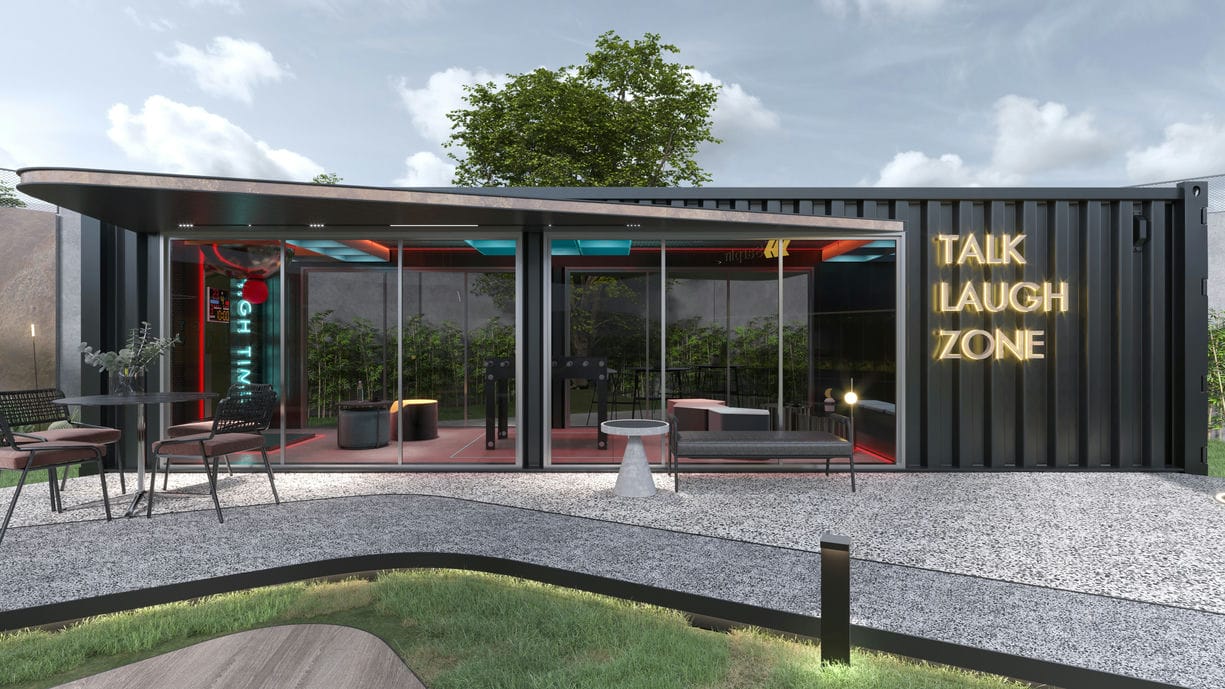TEAM Project » Design Style & Fundamentals » Navigating the Compact Universe of Small Space Living

Navigating the Compact Universe of Small Space Living
Modern interior design problems require modern interior design solutions. A lot of the homes today, especially in places like New York City deal with small and compact spaces. This guide embarks on a journey through the compact universe of small space living, where every square inch holds the potential for innovation, functionality, and personal expression.
The challenge of limited square footage is a familiar tale in cities around the globe, where the luxury of space is often a scarce commodity. However, within these constraints lies a golden opportunity to redefine what makes a space not just livable but lovable. Small spaces compel us to question conventional notions of design, pushing us to think beyond the traditional paradigms of comfort and style. It's about making more out of less, not just in terms of physical space but in the quality of life that space provides.
Embracing small space living requires a shift in perspective. It's an invitation to declutter not just our physical surroundings but our lives, focusing on what truly matters. This guide is designed to navigate through the complexities of designing for small spaces, offering strategies, tips, and innovative solutions that transform cramped quarters into expansive, welcoming environments. From embracing minimalism to mastering the art of illusion, we'll explore how to create spaces that are functional, stylish, and reflective of personal taste.
As we delve into the intricacies of maximizing small interiors, remember that the ultimate goal is not just to make a space seem bigger, but to enhance its functionality, aesthetics, and the overall quality of living within it. With creativity, thoughtful planning, and a keen eye for design, even the most confined spaces can become havens of comfort and style.
Join us as we uncover the secrets to thriving in small spaces, proving that limitations can indeed be the mother of invention and that the size of your living space does not define the richness of your living experience.
Embracing Minimalism in Small Spaces
The Essence of Minimalism
Minimalism, at its core, is about stripping away the unnecessary, leaving room for what truly brings value to our lives. In the context of small space living, this philosophy is not just aesthetic; it's a functional necessity. Embracing minimalism means prioritizing space, clarity, and simplicity, creating an environment that feels open, uncluttered, and at peace.
Benefits of a Minimalist Approach
Enhanced Sense of Space: By reducing clutter and focusing on essential items, minimalism helps in creating the illusion of more space. This is crucial in small interiors where every inch counts.
Increased Functionality: Minimalist design encourages the use of multifunctional furniture and clever storage solutions, making the most out of the available space without sacrificing style or comfort.
Improved Well-being: Clutter-free environments are known to reduce stress and improve mental clarity. A minimalist space can serve as a tranquil retreat from the bustling world outside.
Decluttering Strategies for Small Spaces
One In, One Out Rule: For every new item that comes into your space, ensure an old one is removed. This practice helps maintain balance and prevents accumulation.
Seasonal Decluttering: Allocate time each season to go through your belongings. This regular practice keeps clutter in check and ensures that only items of value and necessity are kept.
Digital Solutions: Embrace digital alternatives where possible. E-books, online subscriptions, and digital photo albums can significantly reduce physical clutter.
Selecting Multifunctional and Minimalist Furniture
Convertible Furniture: Invest in furniture that can serve multiple purposes. A sofa bed, for example, can be a couch during the day and transform into a guest bed at night.
Vertical Storage: Opt for tall, slender shelving units that make use of vertical space. This not only provides ample storage but also draws the eye upward, creating a sense of height.
Hidden Storage: Furniture with built-in storage, like ottomans with internal compartments or beds with drawers underneath, are perfect for stowing away items without taking up additional space.
Embracing Minimalism: A Lifestyle Choice
Adopting minimalism in small spaces goes beyond interior design; it's a lifestyle choice that emphasizes the importance of mindfulness and intentionality in our living environments. By focusing on what truly matters, we can transform our small spaces into serene, functional, and deeply personal havens.
Functionality Meets Design
In the realm of small space living, the intersection of functionality and design is not just a principle—it's a necessity. This section delves into how to seamlessly blend the aesthetic with the practical, ensuring every element within a small interior serves a purpose while contributing to the overall style of the space.
The Importance of Functional Design in Small Spaces
Small interiors demand smart solutions that accommodate daily activities without cluttering the space. The key lies in choosing designs that not only look good but also enhance the usability and flexibility of the area. Functional design considers how space is used, transforming limitations into opportunities for creativity and innovation.
Innovative Furniture Solutions
Transformative and Multi-Use Pieces: The market is ripe with furniture designed for small spaces, featuring pieces that transform and adapt to various needs. Consider a wall-mounted table that folds down for dining or a bed that converts into a sofa. These pieces can change function with minimal effort, offering flexibility without sacrificing valuable square footage.
Built-in and Modular Options: Custom built-ins are a game-changer in small spaces, providing tailored storage and furniture solutions that fit perfectly into your specific dimensions. Modular furniture systems offer similar benefits, with the added ability to reconfigure layouts as needs change, ensuring the space can evolve with your lifestyle.
Utilizing Smart Home Technology for Efficiency
Smart home technology has revolutionized how we interact with our living spaces, offering ways to enhance convenience and control. In small spaces, where efficiency is paramount, these innovations can make a significant impact:
Smart Lighting: Programmable lighting systems allow for the adjustment of brightness and color temperature to suit different times of day or activities, creating the illusion of a larger space and enhancing the mood.
Voice-Controlled Devices: Voice-activated assistants can control various home functions—such as lighting, temperature, and entertainment—without the need for physical switches or remote controls, reducing clutter.
Compact, Multifunctional Appliances: From combination washer-dryers to compact, smart ovens, today's appliances are designed to fit into small spaces while offering multiple functions, saving both space and time.
Practical Tips for Integrating Functionality and Design:
Assess Your Needs: Before investing in furniture or technology, carefully consider your daily routines and what you need from your space. This thoughtful approach ensures that every addition serves a purpose.
Opt for Quality Over Quantity: In small spaces, choosing a few high-quality, functional pieces can be more effective than filling the room with items that don't offer versatility or durability.
Embrace Vertical Solutions: Look to walls and unused vertical spaces for storage and functionality. Mounted shelves, hanging lights, and even vertical gardens can enhance both the design and utility of small interiors.
By prioritizing functionality within design, small spaces can be transformed into efficient, stylish, and adaptable living environments. This approach not only addresses the practical challenges of limited square footage but also opens up new possibilities for creative and personalized interiors.
The Art of Illusion
Creating the illusion of more space is an essential skill in the toolkit of anyone living in or designing small spaces. This section explores how strategic design choices can visually expand interiors, making them feel more open and airy. By manipulating light, color, and perspective, you can trick the eye into perceiving a small space as larger and more inviting.
Techniques to Make Small Spaces Appear Larger
Mirrors: Perhaps the most straightforward and effective tool for creating the illusion of space, mirrors reflect light and views, doubling the visual depth of a room. Placing a large mirror on one wall or a group of smaller mirrors together can dramatically open up a small area.
Transparent and Reflective Materials: Furniture and decor made from glass, lucite, or other transparent materials have a minimal visual footprint while adding a modern touch to the decor. Reflective surfaces, like high-gloss paint or metallic finishes, bounce light around a room, enhancing the sense of space.
Strategic Use of Color and Light: Light colors make walls recede, making a room feel more expansive. Use light hues for walls, ceilings, and large pieces of furniture. Ensure the space is well-lit, combining natural light with varied artificial sources to brighten every corner and create a sense of openness.
Incorporating Transparent and Reflective Materials
Incorporating materials that allow light to pass through or reflect it can significantly impact how large a space feels. Here are some ways to integrate these materials into your design:
Furniture Choices: Opt for coffee tables, dining tables, or chairs in glass or acrylic. These pieces serve their function without visually cluttering the space.
Decorative Accents: Use metallic decor, such as brass candle holders or a mirrored tray, to add style and reflect light without taking up much visual space.
Surfaces and Finishes: Consider glossy finishes for cabinetry or reflective tiles for backsplashes. These surfaces contribute to a brighter, more open feel in small kitchens and bathrooms.
Enhancing Spatial Perception with Color and Lighting
Color Schemes: Light, neutral color schemes can make a small room feel larger and brighter. Consider soft tones like off-white, light gray, or pale blue for walls and large furniture pieces. Use bold colors sparingly as accents to draw attention and add depth without overwhelming the space.
Lighting Design: Adequate lighting can transform the perception of space. Aim for a layered lighting approach:
Ambient lighting provides overall illumination (e.g., ceiling fixtures).
Task lighting focuses light on specific areas for reading or cooking (e.g., under-cabinet lights).
Accent lighting highlights architectural features or decor (e.g., picture lights).
Practical Tips for Implementing the Art of Illusion:
Position Mirrors Strategically: Place mirrors opposite windows to maximize natural light and outdoor views, or use them to reflect a particularly appealing part of the room.
Choose the Right Scale: In small spaces, it's crucial to select furniture and decor that match the room's scale. Oversized pieces can overwhelm, while too many small items can create a cluttered look.
Declutter and Simplify: A minimalist approach goes hand in hand with creating the illusion of space. Keep surfaces clear, and choose decor that doubles as storage to reduce visual clutter.
By mastering the art of illusion, you can make even the smallest spaces feel more open, welcoming, and comfortable. These strategies, grounded in the principles of design and human perception, are key to enhancing the functionality and aesthetics of compact interiors.
Strategic Storage Solutions
Effective storage solutions are the backbone of maximizing small spaces, ensuring that every item has a place while maintaining a clutter-free and aesthetically pleasing environment. This section delves into overcoming storage challenges through creative ideas, custom solutions, and hidden compartments designed to make the most out of every inch.
Overcoming Storage Challenges in Small Spaces
The first step in addressing storage in small spaces is recognizing that traditional storage methods may not suffice. Instead, innovative approaches that utilize overlooked spaces and multifunctional furniture can provide the necessary storage without compromising on style or living area.
Creative Storage Ideas Beyond Traditional Shelving and Drawers
Under Furniture Storage: The space beneath beds and sofas can be utilized for storage bins or built-in drawers, perfect for out-of-season clothing, extra bedding, or items not used daily.
Over-the-Door Solutions: Over-the-door organizers can transform the back of any door into valuable storage for shoes, accessories, or cleaning supplies, keeping these items out of sight but easily accessible.
Ceiling-mounted Shelves: In rooms where floor space is at a premium, look up. Ceiling-mounted shelves can store books, kitchenware, or decorative items without taking up valuable floor space.
Custom Storage Solutions and Hidden Compartments
Built-in Units: Custom built-in shelving and cabinetry can be tailored to the exact dimensions and needs of your space, providing seamless and efficient storage. Consider built-ins for entertainment centers, bookshelves, or wardrobes.
Furniture with Hidden Storage: Many modern furniture pieces are designed with hidden compartments—ottomans that open up to reveal storage, beds with lift-up mattresses for under-mattress storage, or coffee tables with hidden drawers.
Utilizing Wall Space: Install wall-mounted racks, hooks, or magnetic strips in kitchens, bathrooms, or entryways to keep utensils, towels, or keys organized and off countertops and tables.
Practical Tips for Integrating Strategic Storage
Assess Your Storage Needs: Take inventory of what you need to store and categorize items by how frequently they are used. This assessment will guide where and how you store different items to maximize efficiency and accessibility.
Dual-Purpose Furniture: Invest in furniture that offers additional storage. Look for beds with drawers, dining tables with storage underneath, or seating with hidden compartments.
Vertical Space is Key: Don't neglect the potential of vertical space for storage. Tall shelving units, hanging pots and pans in the kitchen, or using stackable storage can dramatically increase your storage capacity.
Declutter Regularly: A crucial aspect of maintaining effective storage in small spaces is regular decluttering. Keep only what you need or love, and be willing to part with items that no longer serve a purpose.
Strategic storage solutions are about thinking outside the box and making every square inch work harder. By employing these tips and integrating smart storage into your design, you can create a small space that is both functional and free from clutter, proving that limited space does not have to mean limited storage options.
Flexible Living Areas
Designing flexible living areas is essential in small spaces, where the functionality of a single room may need to shift based on time of day, occasion, or changing needs. This section explores how to create versatile spaces that serve multiple functions without sacrificing comfort or style.
Designing Versatile Spaces for Multiple Functions
In small interiors, rooms often need to multitask. A living area might also serve as a dining room, home office, or even a guest bedroom. Achieving this flexibility requires thoughtful planning and adaptable furnishings.
Modular Furniture: Modular sofas, extendable dining tables, and stackable chairs allow you to reconfigure your space for different uses. Furniture on casters can be easily moved aside to create open space for exercise or play.
Convertible Pieces: Invest in pieces that transform — a murphy bed that folds up into a wall cabinet, a desk that extends from a bookshelf, or a coffee table that lifts to dining height. These solutions let you change the function of your space with minimal effort.
Room Dividers: Use shelves, curtains, or folding screens as flexible room dividers. These can segment a space for privacy or focus, such as creating a secluded work area or dividing a bedroom from a living space, and can be easily moved or removed as needed.
Zoning Techniques and Temporary Partitions for Space Definition
Defining different areas within a small space helps in organizing activities and enhancing functionality.
Rugs and Lighting: Differentiate zones with area rugs and distinct lighting fixtures. A rug can anchor a living area, while pendant lights over a dining table or desk define those spaces.
Open Shelving: Instead of solid partitions, use open shelving units as dividers that provide storage and display space without blocking light.
Multifunctional Partitions: Consider partitions that double as storage or display space, like a bookshelf that separates a living area from a sleeping space, adding function and style.
Furniture and Accessories that Adapt to Different Needs
Choosing the right furniture and accessories is key to creating a flexible living area.
Foldable/Stackable Items: Chairs and tables that fold or stack can be stored when not in use, freeing up space for other activities.
Vertical Storage: Tall, narrow shelving units take up minimal floor space while providing ample storage, helping to keep the area organized and adaptable.
Tech Integration: Wireless technology and smart devices reduce the need for cumbersome cables and hardware, making it easier to adapt the space for different uses.
Practical Tips for Creating Flexible Living Areas
Plan for Flow: Ensure your layout allows for easy movement between areas, even when furniture is reconfigured.
Invest in Quality: Multifunctional and convertible pieces see a lot of use. Choose durable, well-made items that will withstand frequent changes.
Prioritize Open Space: Resist the urge to fill every corner. Keeping some open space makes it easier to adapt the area for various activities.
Flexible living areas are the cornerstone of maximizing small spaces, offering the freedom to live, work, and relax in a way that suits your lifestyle, no matter the size of your home. With creativity and the right furnishings, you can design a space that effortlessly transitions between functions, proving that a small footprint doesn't have to limit your lifestyle.
Lighting Design
In small spaces, the right lighting design is crucial not only for functionality but also for enhancing the aesthetic appeal and perceived size of the area. A thoughtful lighting plan can transform a cramped space into one that feels cozy, spacious, and inviting. This section delves into the importance of lighting in small interior spaces and how to effectively layer different types of lighting to achieve depth, warmth, and a greater sense of openness.
Importance of Lighting in Small Interior Spaces
Lighting plays a pivotal role in shaping our perception of space. In small interiors, where natural light may be limited, the strategic use of artificial lighting becomes even more critical. Proper lighting can make a room feel larger, highlight architectural features or decor, and create a mood that enhances the overall living experience.
Layering Different Types of Lighting for Depth and Warmth
The key to effective lighting in any space, especially small ones, is layering. By combining various types of lighting, you can control the ambiance and functionality of the area while also making it appear more spacious.
Ambient Lighting: This is the primary source of light in a room, usually coming from ceiling fixtures, recessed lighting, or natural light through windows. Ambient lighting provides a uniform level of illumination throughout the space and establishes the overall mood.
Task Lighting: Task lighting focuses light on specific areas where activities like reading, cooking, or working take place. Desk lamps, under-cabinet lights, and pendant lamps are examples of task lighting that enhance functionality and prevent eye strain.
Accent Lighting: Accent or decorative lighting is used to highlight architectural features, artwork, or other focal points within the room. It adds depth and dimension to the space, drawing the eye to different areas and creating visual interest.
Natural Light Maximization Techniques
Maximizing natural light can make a small space feel more open and connected to the outdoors. Here are some strategies to enhance the amount of natural light in your interior:
Use Reflective Surfaces: Mirrors strategically placed opposite windows can reflect light deep into the room, amplifying the natural light available.
Choose Light Window Treatments: Opt for sheer curtains or blinds that allow light to penetrate while offering privacy. Consider retractable or roll-up shades that can be completely hidden when not in use.
Keep Windows Clean: Regularly cleaning windows inside and out ensures maximum light can enter the space, a simple but often overlooked step in maximizing natural light.
Practical Tips for Implementing Effective Lighting Design
Consider the Color Temperature: Warm light creates a cozy, welcoming atmosphere, while cool light can make a space feel more open and airy. Choose light bulbs with the appropriate color temperature for the desired effect in each area of your home.
Use Dimmers: Installing dimmer switches allows you to adjust the lighting level according to the time of day or the activity, adding versatility to your lighting scheme.
Incorporate LED Strips: LED strip lighting can be used under cabinets, along shelves, or behind mirrors to add subtle illumination and visual interest without taking up space.
Be Creative with Placement: Don't be afraid to use floor lamps, wall sconces, or even battery-operated lights in places where wiring may be an issue. The goal is to distribute light evenly and eliminate dark corners that can make a space feel smaller.
By carefully considering and implementing a layered lighting design, you can dramatically enhance the functionality, mood, and perceived size of small interior spaces. Effective lighting not only illuminates but also transforms, turning compact areas into welcoming, dynamic environments.
Color and Texture
Color and texture are powerful tools in the design of small spaces, influencing perception, mood, and the overall aesthetic appeal. The strategic use of these elements can transform a cramped area into a visually spacious and inviting environment. This section explores how to select and apply colors and textures to enhance small interiors, offering practical tips for creating depth, interest, and warmth.
Selecting Colors to Enhance Small Spaces
The colors chosen for a small space can significantly affect how large or small it feels. While light colors are traditionally recommended to make a room appear larger, there are ways to incorporate darker hues without overwhelming the space.
Light and Neutral Tones: Pale blues, soft grays, and creamy whites reflect more light, making walls seem to recede and creating a sense of openness. Applying these hues as a base color can brighten the space and provide a versatile backdrop for decor.
Bold Accents: Use vibrant colors for accent pieces, artwork, or a single feature wall to inject personality and focus without shrinking the perceived size of the room. Bold colors draw the eye, creating a visual impact without the need for physical space.
Color Harmony: Ensure the colors throughout your space are harmonious. A cohesive color palette unifies the room, making it feel more expansive. Consider using different shades of the same color for a subtle and elegant look.
Incorporating Textures for Depth and Warmth
Texture adds depth and interest to any space, especially important in small interiors where options for adding physical dimension are limited.
Varied Materials: Combine different materials such as wood, metal, glass, and textiles to create a layered look. Each texture reflects light differently, adding complexity and richness to the space.
Soft Furnishings: Rugs, throw pillows, and curtains introduce texture and can soften the harder lines of furniture and architectural features, making the space feel cozier.
Wall and Floor Treatments: Textured wallpapers, decorative wall panels, or patterned floor tiles can add depth without taking up space. Choose subtle patterns to avoid overwhelming the room.
Tips for Using Color and Texture
Maximize Natural Light: Lighter colors and smooth textures reflect light, enhancing natural brightness. Position textured objects and use reflective surfaces to distribute light throughout the room.
Create Focal Points: Use color and texture to create focal points in the room, such as a textured accent wall or a brightly colored piece of furniture. This draws attention and can make the space feel more organized and intentional.
Balance and Contrast: Balance smooth surfaces with textured accents for visual interest without clutter. Similarly, balance neutral tones with pops of color to maintain vibrancy.
Experiment with Scale: Large-format tiles, wide stripes, or big patterns can make a small space seem larger. The key is not to overwhelm the space; use bold patterns selectively and balanced with more subdued elements.
Color and texture are more than just decorative choices; they're strategic tools that can alter the perception of space. By thoughtfully selecting and integrating these elements, you can enhance the visual appeal, functionality, and comfort of small interiors, proving that even limited spaces can be transformed into stylish, welcoming homes.
Smart Organization and Decluttering
Efficient organization and regular decluttering are key to maintaining a functional and aesthetically pleasing small space. This section provides strategies for keeping your small interior tidy and clutter-free, emphasizing smart organization solutions and the importance of decluttering as a lifestyle.
Keeping Small Spaces Tidy and Clutter-Free
In a small space, even a little clutter can have a big impact on the feel and functionality of the room. Effective organization strategies can help maximize space, reduce stress, and improve the overall living experience.
Use Every Inch Wisely: Optimize unused spaces like the backs of doors, under beds, and above cabinets for storage. Vertical storage solutions, such as tall shelving units or hanging organizers, can also maximize space without encroaching on living areas.
Organizational Systems and Gadgets: Invest in organizational tools and gadgets designed for small spaces. Drawer dividers, over-the-door racks, under-shelf baskets, and wall-mounted organizers can keep items neatly stored and easily accessible.
Regular Decluttering Routines and Tips
Decluttering is not just a one-time task but a continuous process that can keep your space functional and visually appealing.
One In, One Out Rule: To prevent accumulation of items, adopt the one in, one out rule. For every new item brought into your space, ensure that an existing item is donated, sold, or recycled.
Seasonal Decluttering: Set aside time for seasonal decluttering sessions. This can involve switching out clothing, reviewing kitchen gadgets, or reassessing decorative items to ensure that your space remains uncluttered and seasonal items are stored away when not in use.
Digital Decluttering: Don't forget about digital clutter. Regularly organizing digital files, unsubscribing from unwanted emails, and decluttering your online life can also contribute to a sense of order and calm in your physical space.
Practical Tips for Implementing Smart Organization and Decluttering
Categorize Items: Group items by category when organizing. This not only makes it easier to find what you need but also helps identify duplicates or unnecessary items that can be decluttered.
Visible Storage: Keep everyday items in visible, easily accessible locations. Use clear containers or open shelving for items you use regularly, reducing the time and effort needed to find them.
Label Everything: Labeling shelves, boxes, and drawers can streamline the organization process and help maintain order. This is especially useful in shared spaces or for items that are stored out of everyday sight.
Embrace Minimalism: Adopting a minimalist approach to possessions can significantly reduce clutter. Focus on quality over quantity, and only keep items that serve a purpose or bring you joy.
Smart organization and regular decluttering are essential for living comfortably in a small space. By creating and maintaining an organized environment, you not only optimize your living area but also create a more peaceful and productive atmosphere. Implementing these strategies can transform your small space into a tidy, efficient, and inviting home.
Personalizing Small Spaces
Adding personal touches to a small space is essential for transforming it from a simple living area into a warm, inviting home that reflects your personality and style. While the challenge in smaller interiors is to personalize without cluttering, strategic choices in art, decor, and accessories can achieve a balance between character and spaciousness. This section offers insights into how to infuse your small space with individuality, ensuring it not only functions well but also truly feels like home.
Art, Decor, and Accessories That Reflect Individual Style
Selecting Meaningful Artwork: Art can be a powerful expression of personal taste and a source of inspiration in daily life. Opt for pieces that resonate with you emotionally or aesthetically. In small spaces, consider one or two larger pieces rather than many small ones to avoid a cluttered look.
Incorporating Personal Memorabilia: Display items that have personal significance, such as photos, souvenirs from travels, or heirlooms. These items tell your story and add layers of meaning to your decor. Use shelves, mantels, or a gallery wall for a cohesive display.
Choosing Decor with Dual Purposes: Look for decorative items that also serve a functional purpose. For example, a beautiful vase can hold fresh flowers to brighten the room, or a decorative box can store remotes or small items neatly.
Solutions for Displaying Personal Items in Limited Spaces
Maximize Vertical Space: Floating shelves or wall-mounted display cases provide a platform for personal items without taking up floor space. Positioning shelves at different heights can draw the eye upward, making the room feel larger.
Rotate Decor: Instead of trying to display everything at once, rotate your decor items seasonally. This keeps the space feeling fresh and allows you to enjoy a variety of personal items throughout the year.
Use Light and Reflection: Place lamps or candles near reflective surfaces or translucent decor to create a warm, inviting glow that enhances the ambiance of your personal displays.
Practical Tips for Personalizing Small Spaces
Focus on Quality Over Quantity: Choose a few high-quality pieces that truly speak to you rather than filling the space with numerous items. This approach ensures your space remains uncluttered and each piece stands out.
Create a Focal Point: Identify an area in your room to serve as a focal point, such as a feature wall or a central table, and personalize this space with art or decor that captures your essence.
Incorporate Textiles: Textiles are an easy way to add color, pattern, and comfort. A distinctive rug, throw pillows, or curtains can significantly impact the room's feel without requiring much space.
Embrace Versatility: Consider using magnetic paint or corkboard walls in areas where you'd like to display artwork or notes. This allows for easy changes and updates to your personal display without permanent commitment.
Personalizing your small space is about making intentional choices that bring joy, comfort, and a sense of identity to your home. By carefully selecting and displaying items that resonate with your personal style and story, you can create a space that not only meets your practical needs but also nourishes your soul and welcomes you warmly every day.
Embracing the Potential of Small Space Living
Our journey through the art of maximizing small interior spaces reveals that limitations in square footage do not dictate the quality of our living environment. Instead, these constraints challenge us to think creatively, act purposefully, and design intelligently, turning potential obstacles into opportunities for innovation and personal expression. This guide has navigated the principles of minimalism, functionality, illusion, storage, flexibility, lighting, color, organization, and personalization, demonstrating that small spaces can indeed be transformed into functional, stylish, and deeply personal havens.
The Heart of Small Space Design
At the core of small space living is the balance between utility and aesthetics, where every choice—from furniture placement to color palette—serves multiple purposes. It's about creating a space that adapts to your needs, reflects your personality, and enhances your daily life, all within a limited footprint. This approach not only maximizes physical space but also contributes to a sense of openness and tranquility, proving that a thoughtfully designed small home can offer just as much, if not more, joy and comfort as a larger one.
Moving Forward with Confidence
Equipped with the strategies and tips explored in this guide, you're now prepared to tackle the challenges of small space living head-on. Remember, the key to success lies in viewing your space as a canvas for creativity and innovation. Regularly assess and adjust your living environment to ensure it meets your evolving needs and reflects your current tastes and preferences. Embrace flexibility, prioritize quality over quantity, and never underestimate the impact of well-considered design choices.
We encourage you to see the potential in every nook, cranny, and corner of your small space. Use this guide as a starting point, but don't be afraid to experiment with ideas that specifically cater to your lifestyle and preferences. Small space living is not just about making do with less; it's about living well, with intention and ingenuity. By embracing the principles outlined here, you can create a small space that is not only efficient and beautiful but also a true reflection of who you are.
In the end, the richness of your living experience in a small space is not measured in square feet but in the quality of its design, the functionality of its layout, and the personal joy it brings. Let's redefine what it means to live in small spaces, transforming them into sources of inspiration, comfort, and creativity.





